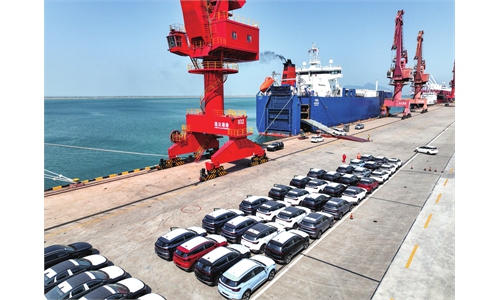Chinese e-commerce exporters ready to face potential end of US' 'de minimis' package rule
American consumers will have to pay for the additional taxes on the products: industry insiders

Deliverymen sort packages in an e-commerce industrial zone in Lianyungang, East China's Jiangsu Province, on June 12, 2023. Photo: VCG
The US is considering to end current tariff exemptions for packages valued under $800, which is seen as a move to crack down on the large amount of goods imported from China in duty-free packages.
Chinese e-commerce exporters said that they are ready to face challenges brought about by the potential US move, while stressing that US consumers will finally have to bear the additional costs, which will add new burden to the current high inflation in the country.
According to a report by the Associated Press on Sunday, US conservatives have set their sights on a top trade priority: cracking down on the deluge of duty-free packages coming in from China. Under current US law, most imports valued at less than $800 enter duty-free into the US as long as they are packaged and addressed to individual buyers. It's referred to as the "de minimis" rule.
"Such thinking reflects the trade protectionism of the US. The current global trend is to oppose trade protectionism and advocate cooperation, win-win results and openness. But the US is acting against such trend," Zhu Qiucheng, CEO of Ningbo New Oriental Electric Industrial Development, told the Global Times on Sunday.
The industry has noticed such news since last year. If the US passes a new bill to cancel the de minimis rule, it will have a great impact on China's cross-border e-commerce industry. A direct impact will be the loss of price advantage for Chinese enterprises, said Zhu, who has been in the e-commerce industry for about 20 years.
So far in 2023, the US imported 395 million packages that benefited from the de minimis rule, accounting for 76.54 percent of total package imports, according to statistics released by the US Customs and Border Protection (CBP) on May 12.
According to a CBP report published in October 2022, packages from China accounted for about 60 percent of its imported de minimis shipment in 2021.
"In fact, with or without a tax exemption, the US market will be a tough sell this year because of weak consumption and inflation. Most Chinese sellers have reported that the exports via e-commerce to the US in the past two months are falling," said Zhu.
A manager surnamed Liu from Chinese e-commerce platform DHgate.com told the Global Times recently that 60 percent of the platform's business is related to the US.
"If tariffs are imposed, it will definitely have a negative impact on us. But the costs would eventually be passed on to the US consumers," Liu said.
US' inflation stood at 4 percent in May on a yearly basis, but the reading was based on an 8.6 percent rise in May 2022. What's more, the May inflation was largely dragged down by the price in energy, which went down 11.7 percent, while the index for all items less food and energy - core inflation - increased by 5.3 percent, according to data released by the US Bureau of Labor Statistics.
"We have actively explored new markets to avoid risks in the US market. Chinese sellers who mainly target the US market will struggle to survive, while the US consumers will have to pay for the additional taxes," a Guangzhou-based e-commerce exporter surnamed Su told the Global Times on Sunday.
To tell the truth, Chinese exporters have begun to prepare to face challenges posed by the US since it initiated the trade war against China several years ago, said Su.
Industry insiders revealed that many Chinese foreign trade enterprises are actively expanding their markets in Southeast Asia, Latin America and Africa, while maintaining orders in the European and American markets.
"In the next five years, e-commerce penetration in Latin America is likely to reach 20-25 percent, and the huge growth is the opportunity for Chinese sellers. And thanks to the Regional Comprehensive Economic Partnership [RCEP], Chinese e-commerce companies also have advantages in the markets of the member countries of the Association of Southeast Asian Nations, Australia, Japan, South Korea and New Zealand," Su noted.
Zhu also said that the industry has been focusing on new markets this year, such as markets involved in the China-proposed Belt and Road Initiative and the RCEP.
China has maintained cross-border e-commerce trading partners all over the world, and has signed bilateral e-commerce cooperation memorandums with 29 countries and regions, according to the data of the Ministry of Commerce (MOFCOM).
There are currently more than 100,000 cross-border e-commerce enterprises and about 690 cross-border e-commerce industrial parks located in comprehensive pilot zones in China. The proportion of trade through cross-border e-commerce in the country's total foreign trade has risen from less than 1 percent in 2018 to about 5 percent at present, per MOFCOM.
China's total cross-border e-commerce reached 2.1 trillion yuan ($279 billion) in 2022, up 7.1 percent year-on-year, accounting for 4.9 percent of its total foreign trade, according to data from the General Administration of Customs.
The US was the largest e-commerce export destination in 2022, accounting for 34.3 percent. It also accounted for 17.9 percent of China's cross-border e-commerce imports, after Japan's 21.7 percent.

